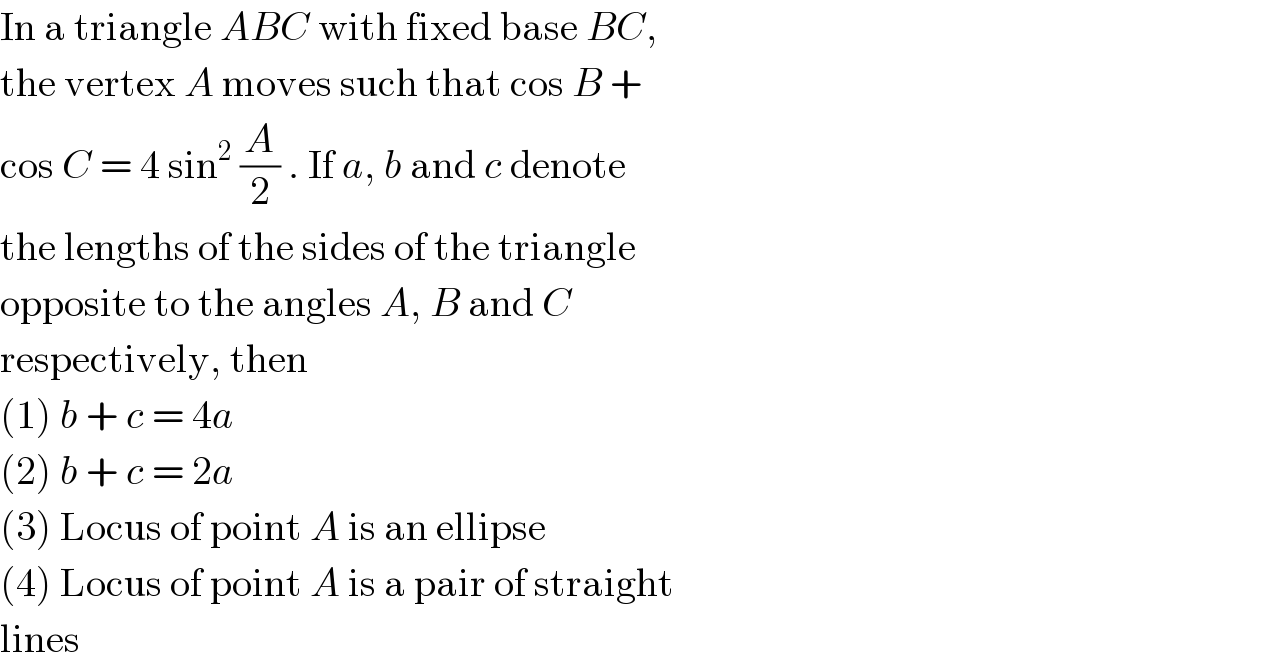
Question and Answers Forum
Question Number 18320 by Tinkutara last updated on 18/Jul/17

Answered by ajfour last updated on 19/Jul/17

Commented by ajfour last updated on 19/Jul/17
![Given: cos B+cos C=4sin^2 (A/2) and a=constant. ⇒ cos B+cos C=2(1−cos A) cos B=(x/c) , cos C=((a−x)/b) , cos A=((b^2 +c^2 −a^2 )/(2bc)) x^2 +y^2 =c^2 (a−x)^2 +y^2 =b^2 subtracting we get a(2x−a)=−(b+c)(b−c) ⇒ x= (a/2)−(((b+c)(b−c))/(2a)) =((a^2 −(b+c)(b−c))/(2a)) .....(i) from given condition (x/c)+((a−x)/b)=2(1−cos A) ⇒ ((ac+x(b−c))/(bc))=2(1−((b^2 +c^2 −a^2 )/(2bc))) replacing x from (i): (( a)/b)+(((b−c)/(2abc)))[a^2 −(b+c)(b−c)] =2[((2bc−(b^2 +c^2 )+a^2 )/(2bc))] 2a^2 c+a^2 (b−c)−(b−c)^2 (b+c) =−2a(b−c)^2 +2a^3 ⇒a^2 (2c+b−c−2a) =(b−c)^2 (b+c−2a) a^2 (b+c−2a)=(b−c)^2 (b+c−2a) ⇒ 2a=b+c or a=∣b−c∣ If we accept : b+c =2a=constant, then locus of A is an ellipse with foci at B and C. If we accept a=∣b−c∣ then A lies on produced BC and on either side.](Q18339.png)
Commented by Tinkutara last updated on 19/Jul/17

| ||
Question and Answers Forum | ||
Question Number 18320 by Tinkutara last updated on 18/Jul/17 | ||
 | ||
Answered by ajfour last updated on 19/Jul/17 | ||
 | ||
Commented by ajfour last updated on 19/Jul/17 | ||
![Given: cos B+cos C=4sin^2 (A/2) and a=constant. ⇒ cos B+cos C=2(1−cos A) cos B=(x/c) , cos C=((a−x)/b) , cos A=((b^2 +c^2 −a^2 )/(2bc)) x^2 +y^2 =c^2 (a−x)^2 +y^2 =b^2 subtracting we get a(2x−a)=−(b+c)(b−c) ⇒ x= (a/2)−(((b+c)(b−c))/(2a)) =((a^2 −(b+c)(b−c))/(2a)) .....(i) from given condition (x/c)+((a−x)/b)=2(1−cos A) ⇒ ((ac+x(b−c))/(bc))=2(1−((b^2 +c^2 −a^2 )/(2bc))) replacing x from (i): (( a)/b)+(((b−c)/(2abc)))[a^2 −(b+c)(b−c)] =2[((2bc−(b^2 +c^2 )+a^2 )/(2bc))] 2a^2 c+a^2 (b−c)−(b−c)^2 (b+c) =−2a(b−c)^2 +2a^3 ⇒a^2 (2c+b−c−2a) =(b−c)^2 (b+c−2a) a^2 (b+c−2a)=(b−c)^2 (b+c−2a) ⇒ 2a=b+c or a=∣b−c∣ If we accept : b+c =2a=constant, then locus of A is an ellipse with foci at B and C. If we accept a=∣b−c∣ then A lies on produced BC and on either side.](Q18339.png) | ||
Commented by Tinkutara last updated on 19/Jul/17 | ||
 | ||